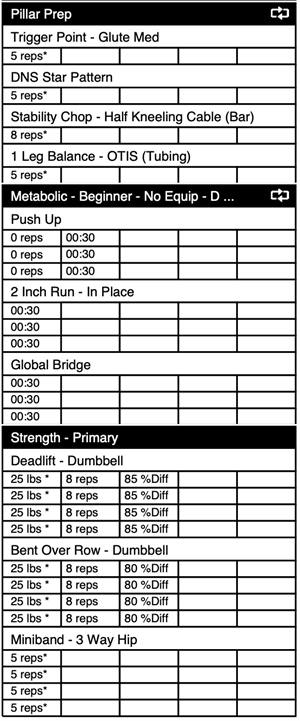
Last week we talked about things NOT to do when starting a strength training program. If you avoid making a lot of those common mistakes then you will probably be on a good path with your program. So now that you know what not to do, let’s talk about the easiest way to start a basic strength training program.
Assess, Don’t Guess
You will always hear me say an assessment is the first step when working towards any goal. Can you start a program without an assessment? Sure. But entering into a fitness program without an assessment will possibly lead to a less efficient program or even cause injuries. Easiest place to start with an assessment is our Level 1 TPI Screen. Based on those results you may be able to jump right into a program or further assessments, such as our Selective Functional Movement Assessment or our Strength and Power Assessments, may be needed to provide us with more information.
Focus on Prime Movers
The prime mover exercises are legs, push, and pull. These 3 motions will produce the greatest bang for the buck. When we do our strength testing we test how much you can push, how much you can pull, and how much you can split squat. These are the first 3 tests because if we struggle with those then there isn’t much of a reason to continue on with additional testing. Pick 1-2 of these exercises as your primary exercises for the workout.
● Legs - Lunge or Split Squat
● Pull - Cable Row
● Push - Cable Chest Press
Multi-Joint Exercises
Again it’s about efficiency. Why do 2 or 3 exercises when you can get a similar result with 1? Focusing on your prime movers should force you into doing a lot of multi-joint exercises. Single joint exercises, such as bicep curls or knee extensions, are fine if we have some weak areas that we really need to focus on. However, most of those exercises are not very functional for golf or even normal activities of daily living. A split squat, for example, is primarily working on hip and knee extension in a functional pattern. If you are doing an exercise and you find yourself only moving one joint during the movement, ask yourself if that exercise is necessary or how you can turn it into a multi-joint exercise. Add in 3-6 (depending on volume) additional multi-joint exercises to supplement your primary exercises.
Start and End with Movement
Always begin and end your workouts with a good warm-up and recovery. Warm-up includes functional movement patterns, foam rolling, and some exercises that get the heart rate up. Recovery should include some stretching, mobility work, or foam rolling. Make sure to spend a good amount of time on each. Ideally, you would want to spend about 5-10 minutes for each warm-up and cool down.
Minimum of 2 Days per Week
It really only takes 2 days a week to start making progress. If you can commit to 3-5+ days per week that is great and you will see results faster, but it's not necessary to start. Each workout should be around 30-60 minutes. The most common way to organize the workouts is to either do total body each day or split upper/lower body. The more days per week you work out the more you would need to have each workout be focused on a specific area.






